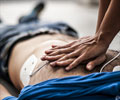A wearable defibrillator can avert sudden death in patients with serious heart arrhythmias, states research presented at the American Heart Association's Scientific Sessions 2011.

The device monitors heart rhythm, emits alarms if a serious arrhythmia occurs, delivers an electric shock to the heart if needed and alerts bystanders to help if the heart's electrical activity has stopped.
About 5,000 patients are using wearable defibrillators at any one time, usually for about 60 days, said Vincent N. Mosesso Jr., M.D., professor of emergency medicine at the University of Pittsburgh School of Medicine and principal investigator of the study.
"In these patients, the wearable defibrillator is a non-invasive 'insurance policy' against sudden arrest during their vulnerable period," he said.
Researchers gathered heart rhythm records and calls about shocks from a registry of 14,475 patients with wearable defibrillators listed from 2007 through 2009. Of those, 185 (about 1 percent) received an appropriate shock and 91.6 percent survived one or more episodes of ventricular fibrillation or ventricular tachycardia, the most common abnormal rhythms during cardiac arrest.
Wearable defibrillators delivered 223 inappropriate shocks to 213 people who weren't experiencing ventricular fibrillation or ventricular tachycardia. However, no one died as a result. Researchers attribute the inappropriate shocks to signal noise, rapid non-VT rhythms, and rhythm misinterpretation.
Advertisement
"This study confirms the effectiveness of very early defibrillation as therapy for sudden cardiac arrest in high-risk patients when delivered by a wearable defibrillator," Mosesso said. "These defibrillators provide patients the critical advantage of not having to wait for a bystander or emergency responder to recognize the cardiac arrest and use an automated external defibrillator or manual defibrillator — both of which can lead to delays in treatment and markedly worse survival rates."
Advertisement















